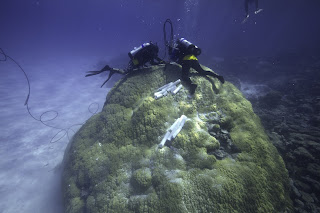On our way home
Here we are at the end of our expedition. It's hard to believe - the time has flown by, but it also feels like ages since began this trip back in Guam a month ago. We were 13 scientists from 5 different research institutions around the world. We traveled more than 3,779 nautical miles (6,997 kilometers) and visited 7 small islands and atolls across the length and width of Micronesia. The trip was a smash success in every sense. Scientifically, we collected 694 whole coral samples, 551 coral tissue samples and 62 reef water samples. We counted coral types and assessed their health along 1,350 meters of coral reef (nearly a mile!). We'll combine the information on water quality with the amount of coral disease to get a good idea of how healthy the reefs are at each site. We drilled 25.2 meters of coral skeleton cores (more than 82.5 feet). The longest cores were up to.4.8 meters tall, nearly 16 feet, and will allow us to build maps of past climate change across Micronesia going back about 400 years.
We also made a lot of friends along the way. We met villagers and chiefs, fishermen and weavers, from 3 tiny atolls and 3 small islands (one atoll was uninhabited). We met scuba divers and government officials working to help preserve and protect their fragile coral reefs. We joined forces with the ship's crew (who helped us drive the boats, make our lunches and fix our equipment, and took care of us in every way), and became a single group dedicated to meeting the goals of our science mission. We gave talks and explained what we were doing, and why, to non-scientists who asked us lots of good questions and helped it all become clearer. Ultimately, we learned a lot about ourselves and the world around us, and learned that Micronesia is a beautiful special part of this planet we call home.
Thank you so much for being a part of our trip. We all enjoyed sharing it with you and we really hope you enjoyed it as well. Remember to work hard, be nice, and have fun. Hope to see you again soon! Read more...











